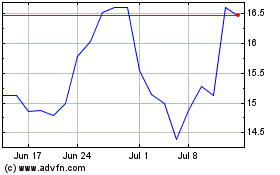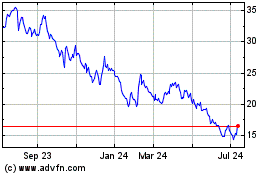U.S. Objects to Abengoa Bankruptcy-Exit Plan
December 01 2016 - 6:00PM
Dow Jones News
The U.S. government, which pumped more than $130 million into
Spanish renewable-energy company Abengoa SA's U.S.-based projects,
is asking a federal judge to put the brakes on the company's plan
to exit bankruptcy.
Several federal agencies—including the Energy and Justice
departments—are objecting to the bankruptcy-exit plan, demanding
changes and at least partial repayment on the government's
investments.
A spokesman for Abengoa couldn't immediately be reached for
comment Thursday on the government's objections.
Judge Kevin Carey is slated to consider the bankruptcy-exit plan
for Abenoga's primary U.S. subsidiary at a hearing on Tuesday at
the U.S. Bankruptcy Court in Wilmington, Del.
The Energy Department had awarded $137 million to fund a total
of 11 Abengoa projects over the past 13 years, according to an
agency spokeswoman. The department says the funds were intended to
help the it meet federal energy policies that promote the
production of ethanol and other renewable energy sources.
In one objection to the plan, the Energy Department said it is
owed about $611,000 from the sale of a York, Neb., ethanol plant as
well as a robotic arm. Beginning in 2003, the federal agency spent
$17 million to help build the plant and to purchase the robot as
part of a program intended to help develop and improve
ethanol-production technologies.
Abengoa is looking to sell the Nebraska plant to Green Plains
Inc. for approximately $1.25 million, and the Energy Department
wants its share of the proceeds. Similarly, a robotic arm the
government purchased with Abengoa for $4 million was recently sold
for $50,000, and the department says it is owed half of the
proceeds.
The Nebraska ethanol plant currently isn't operating, court
papers show. It sits on the site of a 56 million gallon
ethanol-production facility, which was also sold to Green Plains
for $37.4 million. According to court papers, technology and
equipment developed at the pilot plant supported the startup of one
of the first large-scale, second-generation cellulosic ethanol
plants in the U.S.
"That project successfully demonstrated cellulosic ethanol could
be produced at pilot scale and ended in 2012," a spokeswoman for
the Energy Department said Thursday. "The Energy Department has not
incurred a loss as a result of York pilot plant funding—DOE funds
such projects without expectation or means of repayment."
U.S. Trustee Andrew Vara, who serves as a bankruptcy watchdog
for the Justice Department, raised another obstacle to Abengoa's
restructuring plan. In court papers filed Wednesday, he said the
plan is too generous with legal protections that are intended to
shield the company, its current or former management and others
from lawsuits after the bankruptcy. Lawyers for the trustee said in
an objection that the so-called releases are so broad that they may
violate federal law.
The Internal Revenue Service has also weighed in with an
objection, saying it is owed nearly $19 million. Lawyers for the
IRS said in court papers filed Thursday that Abengoa has failed to
file a "significant number" of federal tax returns. Until those tax
returns are filed, the agency asked Judge Carey to keep Abengoa in
bankruptcy.
Founded in Seville, Spain, in 1941, Abengoa is the flagship of
Spain's renewable-energy industry and now develops clean-energy
projects around the world. The company says cuts in clean-energy
subsidies following Spain's 2013 economic crisis forced it to take
on substantial debt—more than $5 billion—to survive.
After a new investment deal fell through, the company launched
preliminary insolvency proceedings in Spain to restructure its
mountain of debt. The move bought Abengoa time to negotiate a
restructuring agreement with creditors and to avoid filing
bankruptcy in Spain, though earlier this year it did launch
bankruptcy proceedings in the U.S.
A Spanish judge has already approved Abengoa's master
restructuring plan, which puts the company under the control of its
banks and bondholders. Abengoa is now asking a U.S. court to
enforce that plan here as well as to approve repayment terms for
U.S. creditors.
Write to Tom Corrigan at tom.corrigan@wsj.com
(END) Dow Jones Newswires
December 01, 2016 17:45 ET (22:45 GMT)
Copyright (c) 2016 Dow Jones & Company, Inc.
Green Plains (NASDAQ:GPRE)
Historical Stock Chart
From Aug 2024 to Sep 2024

Green Plains (NASDAQ:GPRE)
Historical Stock Chart
From Sep 2023 to Sep 2024
